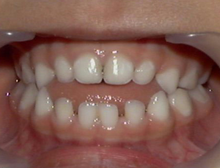Open bite
In dentistry, an open bite is understood to be a misaligned tooth in which the front teeth do not meet when they are bitten, but are spaced apart. Often an open bite results from extensive thumb sucking by the toddler . In this case it is called sucking open bite . Another possible cause for an open bite is a deformation of the jaw in rickets with delayed mineralization of the jaw bone in childhood mainly by lack of vitamin D . With an open bite, a distinction is made between the frontally open bite and the laterally open bite. When the tongue habitually presses against the front teeth of the upper jaw, it can cause speech disorders and lisp .
Differential diagnosis
Dentoalveolar bite open
The dentoalveolar open bite is characterized by a vertical deformation of the upper and / or lower alveolar process in the anterior or posterior region with a balanced or horizontal growth pattern. The vertical proportions of the face are unchanged. Etiologically , exogenous (external) influences such as thumb or finger sucking as well as constant use of pacifiers , tongue clenching or the maintenance of the child's visceral swallowing act with the tongue being embedded between the rows of teeth are decisive. The dentoalveolar open bite is relatively common in the deciduous dentition at 20–30%. The frequency is reduced to about 3 to 8% in mixed dentition .
Skeletal open bite
In a skeletal open bite (structurally or gnathically open bite), the lack of tooth contact is not limited to the anterior region, but often affects the anterior and posterior region. The frequency is given as one percent. Typically, a vertical growth pattern with a divergent rotation of the jaw bases can be seen in the lateral cephalometric image . A high lower face is characteristic and largely genetic. During puberty , an increase or renewed bite opening can be expected.
Thanks to the systematic vitamin D prophylaxis, the open bite caused by rickets rarely occurs.
Iatrogenic open bite
An iatrogenic open bite can occur with unindexed or improper orthodontic treatment.
therapy

A distinction is made between therapy options for children and adults.
Therapy options for growing children and adolescents
- Shielding devices for the tongue (spike apparatus), oral vestibule (MVP)
- Removable braces (Functional Appliance, Side occlusive overlay aids (Bite-blocks))
- Removable braces in combination with extraoral devices (Teuscher activator in combination with a high-pull headgear)
- Multi-bracket apparatus ("fixed clasp")
- Extraction of molars to lower the bite
Treatment options in adult patients
- Shielding devices for the tongue (spike apparatus)
- Multibracket equipment
- Multibracket apparatus in combination with surgical measures at the end of the bite with subsequent oral atrial plate (MVP)
- Grinding in up to the extraction of molars to lower the bite
literature
- Andrea Wichelhaus: Orthodontics - Therapy Volume 1: Basic treatment concepts . Georg Thieme Verlag, December 12, 2012, ISBN 978-3-13-160151-3 , pp. 178-184.
Individual evidence
- ↑ Introduction to orthodontics: diagnostics, treatment planning, therapy: with 10 tables . Deutscher Ärzteverlag, 2010, ISBN 978-3-7691-3419-3 , pp. 282–286.
- ^ Friedbert Schmeil, Ursula Hirschfelder: Orthodontic Zahntechnik . Verlag Neuer Merkur GmbH, 2004, ISBN 978-3-929360-77-6 , pp. 42-43.


